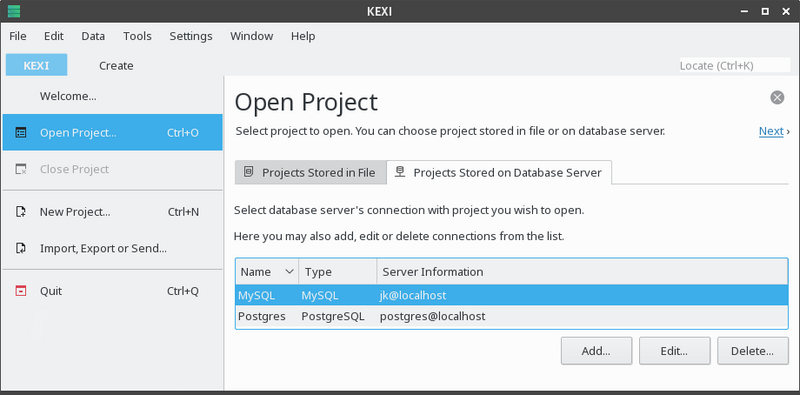Kexi/Handbook/Kexi Basics/Opening an Existing KEXI Project/Selecting a Project from the Open Project Screen: Difference between revisions
Appearance
No edit summary |
No edit summary |
||
| Line 9: | Line 9: | ||
* The screen features two tabbed panes that let you choose files stored locally or on a dedicated database server. | * The screen features two tabbed panes that let you choose files stored locally or on a dedicated database server. | ||
* Choose either | * Choose either of the two tabs. | ||
*The <menuchoice>Projects Stored in File</menuchoice> tab allows you to navigate through your folder hierarchy to locate a file to open, typically a .kexi project stored on your computer or a networked machine. You can either select a file to open immediately or enter the filename in the '''Name''' box. Then, click <menuchoice>Next</menuchoice> or press the <keycap>Enter</keycap> key. | *The <menuchoice>Projects Stored in File</menuchoice> tab allows you to navigate through your folder hierarchy to locate a file to open, typically a .kexi project stored on your computer or a networked machine. You can either select a file to open immediately or enter the filename in the '''Name''' box. Then, click <menuchoice>Next</menuchoice> or press the <keycap>Enter</keycap> key. | ||
| Line 15: | Line 15: | ||
[[Image:kexi_openproject.png|800px|center]] | [[Image:kexi_openproject.png|800px|center]] | ||
*The <menuchoice>Projects Stored on Database Server</menuchoice> tab | *The <menuchoice>Projects Stored on Database Server</menuchoice> tab allows you to select a preconfigured project. Highlight the desired project and click <menuchoice>Next</menuchoice>. | ||
[[Image:Kexi_openproject_server.png|800px|center]] | [[Image:Kexi_openproject_server.png|800px|center]] | ||
| Line 21: | Line 21: | ||
'''Notes''' | '''Notes''' | ||
* By default the <menuchoice>Filter</menuchoice> | * By default, the <menuchoice>Filter</menuchoice> dropdown list in the <menuchoice>Projects Stored in File</menuchoice> tab has the <menuchoice>All Supported Files (*.kexi, *.kexic, *.kexis, .mdb)</menuchoice> filter entry selected. If the file you are looking for has a different extension, you can change the selection in the <menuchoice>Filter</menuchoice> dropdown list to <menuchoice>All Files (*)</menuchoice> to display all available files, regardless of their extension. | ||
* If you | * If you select a file of an external type, such as an '''MS Access''' <tt>.mdb</tt> file, '''KEXI''' will offer the option to import the file. | ||
* If you | * If you select a connection data file (with a <tt>.kexic</tt> extension) or a shortcut to a project on a database server (with a <tt>.kexis</tt> extension), '''KEXI''' will display the appropriate dialogs. | ||
{{Prevnext2 | {{Prevnext2 | ||
Revision as of 19:42, 25 December 2024
Opening a Database File in the Open Project Dialog
- Run KEXI and click the command in the KEXI menu, or go to → , or press the Ctrl+O keys.
- An Open Project screen will appear, allowing you to open an existing project.
- The screen features two tabbed panes that let you choose files stored locally or on a dedicated database server.
- Choose either of the two tabs.
- The tab allows you to navigate through your folder hierarchy to locate a file to open, typically a .kexi project stored on your computer or a networked machine. You can either select a file to open immediately or enter the filename in the Name box. Then, click or press the Enter key.

- The tab allows you to select a preconfigured project. Highlight the desired project and click .

Notes
- By default, the dropdown list in the tab has the filter entry selected. If the file you are looking for has a different extension, you can change the selection in the dropdown list to to display all available files, regardless of their extension.
- If you select a file of an external type, such as an MS Access .mdb file, KEXI will offer the option to import the file.
- If you select a connection data file (with a .kexic extension) or a shortcut to a project on a database server (with a .kexis extension), KEXI will display the appropriate dialogs.
